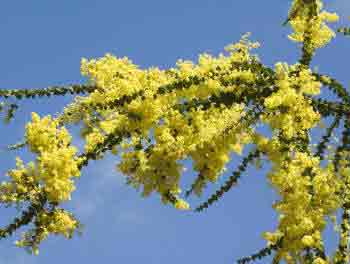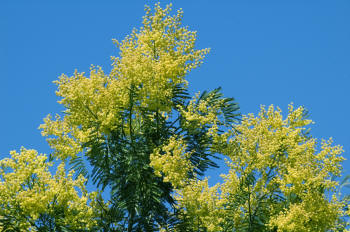Acacia Shrubs – Wattle Plants or Mimosa - How to Grow.
Acacias belong to the wide-ranging group of plants in the Pea family – Leguminosea – Mimosaceae. They are either trees or large shrubs, sometimes climbing plants. Those grown indoors can be classed as Acacia plants – rather than shrubs. The closely-related Mimosa are the plants of indoors. However the common name of Mimosa is often used when talking about true acacias.
All of the common acacias have a distinct advantage of flowering in late winter – a gorgeous sight – and early spring. The delicate-looking ‘pop-pom’ flowers rarely suffer from frosts. Neither does the evergreen foliage which adorns all of the Wattles mentioned in our list below.
They are commonly known as Wattles in Australia, and those grown in Australia are quite different to those in the UK and other temperate area. Wattle shrubs grown in Australia are almost universally thorn less, but those that we know as Acacias in UK are mainly with thorns.
 The
showy golden yellow flowers are the main attraction, with the foliage
coming in a close second! Acacia is sometimes grown as a houseplant and
often sold by florists under the ‘mimosa’ tag. Clusters of small pom-pom
flowers in feathery plumes are well set off by the foliage fronds of
deep green through to silver. The foliage itself is quite an attractive
feature – varied through different varieties, but all with pinnate
leaves.
The
showy golden yellow flowers are the main attraction, with the foliage
coming in a close second! Acacia is sometimes grown as a houseplant and
often sold by florists under the ‘mimosa’ tag. Clusters of small pom-pom
flowers in feathery plumes are well set off by the foliage fronds of
deep green through to silver. The foliage itself is quite an attractive
feature – varied through different varieties, but all with pinnate
leaves.
The branches are quite brittle once mature so any training should be carried out on young growth.
Acacias are essentially for milder, drier areas, for their origins are of hot climates in Australia, South America and some Asian countries. They are not rain-forest plants and drier well-drained areas are the way forward as a starting point. There are many to choose from for garden planting – all of which eventually grow to large shrubs.
The tree varieties of Acacia will be mentioned elsewhere. One tree in particular is often confused as being an Acacia is Robinia pseudoacacia – the FALSE Acacia.
Growing Conditions for Acacia Shrubs
 All
Acacias grown outdoors – either as specimens or as part of a grander
scheme, will need a well drained soil – sandy even – that borders on
acidity rather than alkaline. Sheltered sites, but in full sun is ideal,
but I have also seen some interesting specimens growing in woodland
situations – but not overhung or in shade.
All
Acacias grown outdoors – either as specimens or as part of a grander
scheme, will need a well drained soil – sandy even – that borders on
acidity rather than alkaline. Sheltered sites, but in full sun is ideal,
but I have also seen some interesting specimens growing in woodland
situations – but not overhung or in shade.
Wattles are very undemanding otherwise, with feeding, watering and pruning all being minimal requirements.
Another great plus for the group, is that when grown outdoors they are virtually pest and disease free. (Not so for the tender varieties which are grown under glass, or otherwise indoors. Red spider will almost certainly be a nuisance!)
-
List of Good Garden Acacias
All of the Acacia listed here will grow into large evergreen shrubs – 10 feet plus in 10 years – and then on to 20 feet or so. There is no dwarf Acacia in general cultivation - for UK gardens – unless artificially or culturally adapted!
Whilst remaining evergreen, there is a tendency for some of the leaflets to close up in harsh weather. Not unlike to foliage of the sensitive Mimosa pudica houseplant.
- Acacia baileyana AGM – The Cootamundra Wattle
Height to 4-5 metres with slightly less spread; Ferny foliage, silvery grey – especially as aging takes place; Normal Acacia golden yellow flowers in long racemes of powder puff balls.
- Acacia dealbata – The Silver Wattle or Mimosa
One of the most common and often seen as an attractive container-grown shrub in garden centres. They will get big – small tree rather than large shrub. Flowers late Winter through to Spring. 10m height eventually and very imposing with golden yellow flowers drooping off branched clad in silver grey fery foliage.
- Acacia decurrens – The Black Wattle or sometimes (confusingly) the Green Wattle!
5-6m height with dark-green - fern-like leaves - and normal bright yellow flower balls in showy clusters – often pendulous. Flowering in Spring rather than winter.
- Acacia paradoxa – Acacia armata or more realistically, the Hedge or Kangaroo Thorn Wattle.
Different to the other on account of foliage not being ferny - Top Image - and best described as lance-shaped. Good colour for flowers and is one that can be trimmed to hedge type growth. Otherwise a largish shrub of up to 5metres.
- Acacia pravissima – The Ovens Wattle
Non-ferny foliage, but attractive green or grey-green leaflets. Flower clusters not dense but profuse in late winter through to early spring. This Wattle has the added attraction of being fragrant – especially later afternoon or early morning. It will try to grow to small tree rather than large shrub so position carefully.
Problems with Acacia
The main problem is planting in damp soil conditions, and nurturing the shrub through the first few winters - after which they are generally frost-hardy in sheltered and warmer areas.
Best Selling Gardening Products
Popular Gardening Sections

Problems
Identify Weeds in The Garden - How to deal with weeds. Diseases and Pest which harm your garden and plants, learn how to prevent, deter and erradicate your garden problems.
Garden Problems
Pruning
Pruning Guide. Shrubs flower better with correct pruning. Many illustrations and examples of what to do - and when. Includes evergreens, roses, flowering shrubs, spring flowering shrubs and pruning for stem effect. This is our most viewed and comprehensive section,
Pruning
Gardening Businesses
Gardening Businesses listed in the UK counties and USA states. County and State Listings of businesses involved in Garden supplies and services. If you wish to be added to the Directory, please send us your information. Having problems, use the search box
Businesses
Gardening
In this section you will learn about Gardening Basics, Containers, Landscaping, Propagation and Soil.
Gardening
Gardening Gifts
Gardening Gifts and Reviews, Read Before you Buy
- Gardening Gifts Ideas
- Gifts For Her
- Gifts For Men
- Power Tool Gifts
- Cheap Gifts
- Personalised Gifts
- Wildlife Gifts
- Family Gifts



